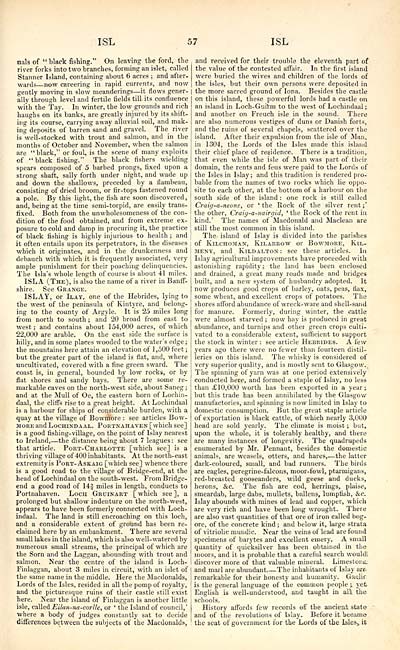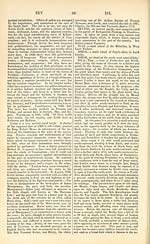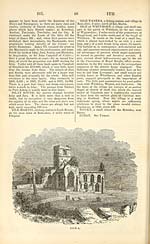Download files
Complete book:
Individual page:
Thumbnail gallery: Grid view | List view

ISL
57
ISL
nals of "black fishing." On leaving the ford, the
river forks into two branches, forming an islet, called
Stanner Island, containing about 6 acres ; and after-
wards — now careering in rapid currents, and now
gently moving in slow meanderings — it flows gener-
ally through level and fertile fields till its confluence
with the Tay. In winter, the low grounds and rich
haughs on its banks, are greatly injured by its shift-
ing its course, carrying away alluvial soil, and mak-
ing deposits of barren sand and gravel. The river
is well-stocked with trout and salmon, and in the
months of October and November, when the salmon
are "black," or foul, is the scene of many exploits
of " black fishing." The black fishers wielding
spears composed of 5 barbed prongs, fixed upon a
strong shaft, sally forth under night, and wade up
and down the shallows, preceded by a flambeau,
consisting of dried broom, or fir-tops fastened round
a pole. By this light, the fish are soon discovered,
and, being at the time semi-torpid, are easily trans-
fixed. Both from the unwholesomeness of the con-
dition of the food obtained, and from extreme ex-
posure to cold and damp in procuring it, the practice
of black fishing- is highly injurious to health; and
it often entails upon its perpetrators, in the diseases
which it originates, and in the drunkenness and
debauch with which it is frequently associated, very
ample punishment for their poaching delinquencies.
The Isla's whole length of course is about 41 miles.
ISLA (The), is also the name of a river in Banff-
shire. See Grange.
ISLAY, or Ilay, one of the Hebrides, lying to
the west of the peninsula of Kintyre, and belong-
ing to the county of Argyle. It is 25 miles long
from north to south; and 20 broad from east to
west ; and contains about 154,000 acres, of which
22,000 are arable. On the east side the surface is
hilly, and in some places wooded to the water's edge ;
the mountains here attain an elevation of 1,500 feet ;
but the greater part of the island is flat, and, where
uncultivated, covered with a fine green sward. The
coast is, in general, bounded by low rocks, or by
flat shores and sandy bays. There are some re-
markable caves on the north-west side, about Saneg ;
and at the Mull of Oe, the eastern horn of Lochin-
daal, the cliffs rise to a great height. At Lochindaal
is a harbour for ships of considerable burden, with a
quay at the village of Bowmore : see articles Bow-
more and Lochindaal. Portnahaven [which see]
is a good fishing-village, on the point of lslay nearest
to Ireland, — the distance being about 7 leagues : see
that article. Port-Charlotte [which see] is a
thriving village of 400 inhabitants. At the north-east
extremityis Port-Askaig [which see] whence there
is a good road to the village of Bridge-end, at the
head of Lochindaal on the south-west. From Bridge-
end a good road of 14J miles in length, conducts to
Portnahaven. Loch Gruinart [which see], a
prolonged but shallow indenture on the north-west,
appears to have been formerly connected with Loch-
indaal. The land is still encroaching on this loch,
and a considerable extent of ground has been re-
claimed here by an embankment. There are several
small lakes in the island, which is also well- watered by
numerous small streams, the principal of which are
the Sorn and the Laggan, abounding with trout and
salmon. Near the centre of the island is Loch-
Finlaggan, about 3 miles in circuit, with an islet of
the same name in the middle. Here the Macdonalds,
Lords of the Isles, resided in all the pomp of royalty,
and the picturesque ruins of their castle still exist
here. Near the island of Finlaggan is another little
isle, called Eilan-na-corlle, or ' the Island of council,'
where a body of judges constantly sat to decide
differences between the subjects of the Macdonalds,
and received for their trouble the eleventh part of
I the value of the contested affair. In the first island
were buried the wives and children of the lords of
[ the isles, but their own persons were deposited in
| the more sacred ground of Iona. Besides the castle
on this island, these powerful lords had a castle on
an island in Loch-Guirm to the west of Lochindaal ;
and another on Freuch isle in the sound. There
are also numerous vestiges of duns or Danish forts,
and the ruins of several chapels, scattered over the
island. After their expulsion from the isle of Man,
in 1304, the Lords of the Isles made this island
their chief place of residence. There is a tradition,
that even while the isle of Man was part of their
domain, the rents and feus were paid to the Lords of
the Isles in lslay; and this tradition is rendered pro-
bable from the names of two rocks which lie oppo-
site to each other, at the bottom of a harbour on the
south side of the island : one rock is still called
Craig-a-neone, or ' the Rock of the silver rent ;'
the other, Craiy-a-nairgid, ' the Rock of the rent in
kind.' The names of Macdonald and Maclean are
still the most common in this island.
The island of lslay is divided into the parishes
of KlLCHOMAN, KlLARROW Or BoWJKBE, KlL-
ment, and Kildalton : see these articles. In
lslay agricultural improvements have proceeded with
astonishing rapidity; the land has been enclosed
and drained, a great many roads made and bridges
built, and a new system of husbandry adopted. It
now produces good crops of barley, oats, peas, flax,
some wheat, and excellent crops of potatoes. The
shores afford abundance of wreck- ware and shell-sand
for manure. Formerly, during winter, the cattle
were almost starved; now hay is produced in great
abundance, and turnips and other green crops culti-
vated to a considerable extent, sufficient to support
the stock in winter : see article Hebrides. A few
years ago there were no fewer than fourteen distil-
leries on this island. The whisky is considered of
very superior quality, and is mostly sent to Glasgow.
The spinning of yarn was at one period extensively
conducted here, and formed a staple of lslay, no less
than £10,000 worth has been exported in a year;
but this trade has been annihilated by the Glasgow
manufactories, and spinning is now limited in lslay to
domestic consumption. But the great staple article
of exportation is black cattle, of which nearly 3,000
head are sold yearly. The climate is moist ; but,
upon the whole, it is tolerably healthy, and there
are many instances of longevity. The quadrupeds
enumerated by Mr. Pennant, besides the domestic
animals, are weasels, otters, and hares, — the latter
dark-coloured, small, and bad runners. The birds
are eagles, peregrine-falcons, moor-fowl, ptarmigans,
red-breasted gooseanders, wild geese and ducks,
herons, &c. The fish are cod, herrings, plaise,
smeardab, large dabs, mullets, ballens, lumptish, &c.
lslay abounds with mines of lead and copper, which
are very rich and have been long wrought. There
are also vast quantities of that ore of iron called bog-
ore, of the concrete kind ; and below it,, large strata
of vitriolic mundic. Near the veins of lead are found
specimens of barytes and excellent emery. A small
quantity of quicksilver has been obtained in the
moors, and it is probable that a careful search wouldl
discover more of that valuable mineral. Limestone;
and marl are abundant The inhabitants of lslay a»i
remarkable for their honesty and humanity. Gaelic
is the general language of the common people ; yet
English is well-understood, and taught in all the
schools.
History affords few records of the ancient state
and of the revolutions of lslay. Before it became
the seat of government for the Lords of the Isles,, it
57
ISL
nals of "black fishing." On leaving the ford, the
river forks into two branches, forming an islet, called
Stanner Island, containing about 6 acres ; and after-
wards — now careering in rapid currents, and now
gently moving in slow meanderings — it flows gener-
ally through level and fertile fields till its confluence
with the Tay. In winter, the low grounds and rich
haughs on its banks, are greatly injured by its shift-
ing its course, carrying away alluvial soil, and mak-
ing deposits of barren sand and gravel. The river
is well-stocked with trout and salmon, and in the
months of October and November, when the salmon
are "black," or foul, is the scene of many exploits
of " black fishing." The black fishers wielding
spears composed of 5 barbed prongs, fixed upon a
strong shaft, sally forth under night, and wade up
and down the shallows, preceded by a flambeau,
consisting of dried broom, or fir-tops fastened round
a pole. By this light, the fish are soon discovered,
and, being at the time semi-torpid, are easily trans-
fixed. Both from the unwholesomeness of the con-
dition of the food obtained, and from extreme ex-
posure to cold and damp in procuring it, the practice
of black fishing- is highly injurious to health; and
it often entails upon its perpetrators, in the diseases
which it originates, and in the drunkenness and
debauch with which it is frequently associated, very
ample punishment for their poaching delinquencies.
The Isla's whole length of course is about 41 miles.
ISLA (The), is also the name of a river in Banff-
shire. See Grange.
ISLAY, or Ilay, one of the Hebrides, lying to
the west of the peninsula of Kintyre, and belong-
ing to the county of Argyle. It is 25 miles long
from north to south; and 20 broad from east to
west ; and contains about 154,000 acres, of which
22,000 are arable. On the east side the surface is
hilly, and in some places wooded to the water's edge ;
the mountains here attain an elevation of 1,500 feet ;
but the greater part of the island is flat, and, where
uncultivated, covered with a fine green sward. The
coast is, in general, bounded by low rocks, or by
flat shores and sandy bays. There are some re-
markable caves on the north-west side, about Saneg ;
and at the Mull of Oe, the eastern horn of Lochin-
daal, the cliffs rise to a great height. At Lochindaal
is a harbour for ships of considerable burden, with a
quay at the village of Bowmore : see articles Bow-
more and Lochindaal. Portnahaven [which see]
is a good fishing-village, on the point of lslay nearest
to Ireland, — the distance being about 7 leagues : see
that article. Port-Charlotte [which see] is a
thriving village of 400 inhabitants. At the north-east
extremityis Port-Askaig [which see] whence there
is a good road to the village of Bridge-end, at the
head of Lochindaal on the south-west. From Bridge-
end a good road of 14J miles in length, conducts to
Portnahaven. Loch Gruinart [which see], a
prolonged but shallow indenture on the north-west,
appears to have been formerly connected with Loch-
indaal. The land is still encroaching on this loch,
and a considerable extent of ground has been re-
claimed here by an embankment. There are several
small lakes in the island, which is also well- watered by
numerous small streams, the principal of which are
the Sorn and the Laggan, abounding with trout and
salmon. Near the centre of the island is Loch-
Finlaggan, about 3 miles in circuit, with an islet of
the same name in the middle. Here the Macdonalds,
Lords of the Isles, resided in all the pomp of royalty,
and the picturesque ruins of their castle still exist
here. Near the island of Finlaggan is another little
isle, called Eilan-na-corlle, or ' the Island of council,'
where a body of judges constantly sat to decide
differences between the subjects of the Macdonalds,
and received for their trouble the eleventh part of
I the value of the contested affair. In the first island
were buried the wives and children of the lords of
[ the isles, but their own persons were deposited in
| the more sacred ground of Iona. Besides the castle
on this island, these powerful lords had a castle on
an island in Loch-Guirm to the west of Lochindaal ;
and another on Freuch isle in the sound. There
are also numerous vestiges of duns or Danish forts,
and the ruins of several chapels, scattered over the
island. After their expulsion from the isle of Man,
in 1304, the Lords of the Isles made this island
their chief place of residence. There is a tradition,
that even while the isle of Man was part of their
domain, the rents and feus were paid to the Lords of
the Isles in lslay; and this tradition is rendered pro-
bable from the names of two rocks which lie oppo-
site to each other, at the bottom of a harbour on the
south side of the island : one rock is still called
Craig-a-neone, or ' the Rock of the silver rent ;'
the other, Craiy-a-nairgid, ' the Rock of the rent in
kind.' The names of Macdonald and Maclean are
still the most common in this island.
The island of lslay is divided into the parishes
of KlLCHOMAN, KlLARROW Or BoWJKBE, KlL-
ment, and Kildalton : see these articles. In
lslay agricultural improvements have proceeded with
astonishing rapidity; the land has been enclosed
and drained, a great many roads made and bridges
built, and a new system of husbandry adopted. It
now produces good crops of barley, oats, peas, flax,
some wheat, and excellent crops of potatoes. The
shores afford abundance of wreck- ware and shell-sand
for manure. Formerly, during winter, the cattle
were almost starved; now hay is produced in great
abundance, and turnips and other green crops culti-
vated to a considerable extent, sufficient to support
the stock in winter : see article Hebrides. A few
years ago there were no fewer than fourteen distil-
leries on this island. The whisky is considered of
very superior quality, and is mostly sent to Glasgow.
The spinning of yarn was at one period extensively
conducted here, and formed a staple of lslay, no less
than £10,000 worth has been exported in a year;
but this trade has been annihilated by the Glasgow
manufactories, and spinning is now limited in lslay to
domestic consumption. But the great staple article
of exportation is black cattle, of which nearly 3,000
head are sold yearly. The climate is moist ; but,
upon the whole, it is tolerably healthy, and there
are many instances of longevity. The quadrupeds
enumerated by Mr. Pennant, besides the domestic
animals, are weasels, otters, and hares, — the latter
dark-coloured, small, and bad runners. The birds
are eagles, peregrine-falcons, moor-fowl, ptarmigans,
red-breasted gooseanders, wild geese and ducks,
herons, &c. The fish are cod, herrings, plaise,
smeardab, large dabs, mullets, ballens, lumptish, &c.
lslay abounds with mines of lead and copper, which
are very rich and have been long wrought. There
are also vast quantities of that ore of iron called bog-
ore, of the concrete kind ; and below it,, large strata
of vitriolic mundic. Near the veins of lead are found
specimens of barytes and excellent emery. A small
quantity of quicksilver has been obtained in the
moors, and it is probable that a careful search wouldl
discover more of that valuable mineral. Limestone;
and marl are abundant The inhabitants of lslay a»i
remarkable for their honesty and humanity. Gaelic
is the general language of the common people ; yet
English is well-understood, and taught in all the
schools.
History affords few records of the ancient state
and of the revolutions of lslay. Before it became
the seat of government for the Lords of the Isles,, it
Set display mode to: Large image | Transcription
Images and transcriptions on this page, including medium image downloads, may be used under the Creative Commons Attribution 4.0 International Licence unless otherwise stated. ![]()
| Gazetteers of Scotland, 1803-1901 > Topographical, statistical, and historical gazetteer of Scotland > Volume 2 > (67) Page 57 |
|---|
| Permanent URL | https://digital.nls.uk/97449394 |
|---|
| Description | Volume second: I-Z. |
|---|---|
| Shelfmark | Map Room Ref.2 |
| Attribution and copyright: |
|

